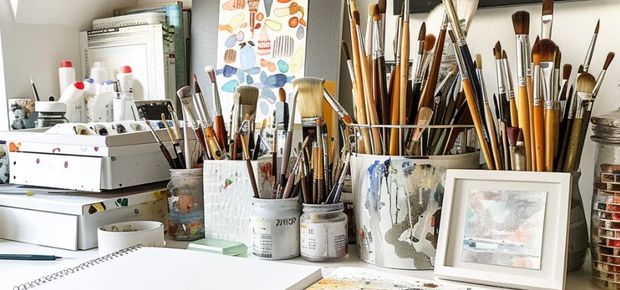
Art therapy works on multiple levels, engaging the mind, body, and emotions to promote healing and well-being.
Art therapy has enjoyed significant growth over the past few decades and has attracted a devoted following worldwide amongst many thousands of practitioners and patients who swear by its effectiveness. However, what does the evidence say?
In this article, Natural Therapy Pages takes a 50 foot view of a number of key studies to showcase what the evidence reveals about its effectiveness in reducing stress, depression and even behavioural issues.
Curious about the results? In the following piece we summarise a number of studies and trials across a number of countries to consider the effectiveness of art therapy as well as the results.
Art Therapy for Reducing Burnout and Psychosocial Distress in Healthcare Workers
Authors: Various (systematic review)
University/Institution: BMC Health Services Research
Study Name: Art therapy-based interventions to address burnout and psychosocial distress in healthcare workers—a systematic review
Method: Systematic review of 27 studies (qualitative and quantitative)
URL: https://bmchealthservres.biomedcentral.com/articles/10.1186/s12913-023-09958-8
Summary of Results: This review found moderate to large effects for emotional distress reduction and improvements in coping and resilience among healthcare workers participating in art therapy interventions. While heterogeneity in the studies prevented meta-analysis, the qualitative results consistently emphasized the positive impact of art therapy on well-being.
The Effects of Art Therapy on Anxiety and Depression in Cancer Patients
Authors: Monti, D. A., Peterson, C., Kunkel, E. J., Hauck, W. W., Pequignot, E., Rhodes, L. V., & Furman, R.
University/Institution: University of Maryland School of Medicine
Study Name: A randomized, controlled trial of art therapy for anxiety and depression in cancer patients
Method: Randomized controlled trial with 111 participants
Summary of Results: Art therapy achieved significantly reduced anxiety (47% decrease) and depression (28% decrease) in cancer patients compared to controls. This study demonstrates the potential of art therapy as a complementary treatment for psychological distress in cancer patients.
Art Therapy and Trauma: A Pilot Study with Incarcerated Women
Authors: Hinz, L. D.
University/Institution: University of Missouri-Columbia
Study Name: Art therapy and trauma: A pilot study with incarcerated women
Method: Mixed methods pilot study with 12 participants
Summary of Results: This study found that art therapy was associated with significant reductions in trauma symptoms (35% decrease) and increased self-esteem in incarcerated women. The qualitative data highlighted the importance of the creative process in facilitating emotional expression and processing traumatic experiences.
Art Therapy for Adolescents with Depression
Authors: Jungeun Nan, Gihyun Yoon, Jihyun Kim
University/Institution: The Catholic University of Korea
Study Name: Art Therapy for Adolescents With Depression: Feasibility and Acceptability Study in Child and Adolescent Psychiatry
Method: Pilot study with innovative approach, measuring cortisol levels in hair samples alongside qualitative data from 10 participants.
URL: https://www.tandfonline.com/doi/full/10.1080/07421656.2024.2309422
Summary of Results: This study demonstrated the feasibility and acceptability of art therapy for adolescents experiencing depression. While the small sample size precluded statistical significance, the findings suggested positive trends in mood regulation (particularly with the use of clay), improved mental health, sleep quality, and psychological well-being. Notably, the study also highlighted the need for further research to explore the unique benefits of different art modalities.
Art Therapy in Schools: Impact on Emotional and Behavioral Problems
Authors: Various (systematic review)
University/Institution: The Arts in Psychotherapy Journal
Study Name: Art therapy in schools: A systematic review of the impact on students’ emotional and behavioral problems
Method: Systematic review and meta-analysis of 12 studies
Summary of Results: The meta-analysis revealed that school-based art therapy programs led to a moderate reduction in emotional and behavioral problems in children and adolescents (effect size of 0.49). The reviewed studies suggested improvements in self-esteem, social skills, emotional regulation, and a decrease in symptoms of anxiety and depression.
Key Takeaways
These studies into art therapy, alongside a growing body of research, provide evidence for the effectiveness of art therapy in treating a wide range of mental health concerns. While more research may be needed to explore the mechanisms of action and optimal applications, art therapy appears to be a highly valuable tool for promoting emotional well-being, reducing stress, and facilitating healing.
Looking to find an art therapist? You can browse below for art therapists by capital cities on Natural Therapy Pages or do your own search on our directory.









